2006 LAND ROVER FRELANDER 2 ECU
[x] Cancel search: ECUPage 2727 of 3229
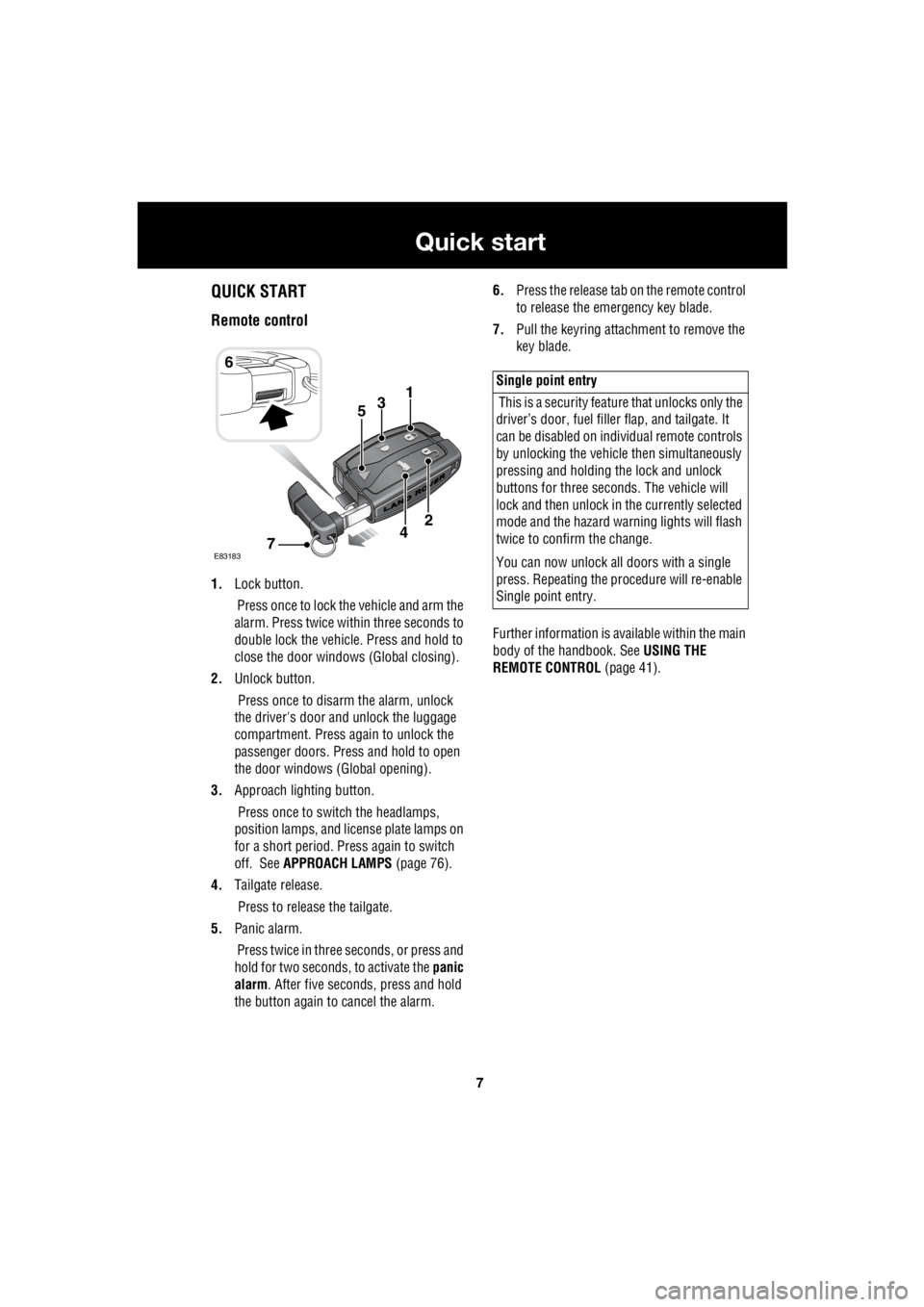
7
Quick start
R
Quick startQUICK START
Remote control
1. Lock button.
Press once to lock the vehicle and arm the
alarm. Press twice within three seconds to
double lock the vehicle. Press and hold to
close the door windows (Global closing).
2. Unlock button.
Press once to disarm the alarm, unlock
the driver's door and unlock the luggage
compartment. Press again to unlock the
passenger doors. Press and hold to open
the door windows (Global opening).
3. Approach lighting button.
Press once to switch the headlamps,
position lamps, and license plate lamps on
for a short period. Press again to switch
off. See APPROACH LAMPS (page 76).
4. Tailgate release.
Press to release the tailgate.
5. Panic alarm.
Press twice in three seconds, or press and
hold for two seconds, to activate the panic
alarm . After five seconds, press and hold
the button again to cancel the alarm. 6.
Press the release tab on the remote control
to release the emergency key blade.
7. Pull the keyring attachment to remove the
key blade.
Further information is available within the main
body of the handbook. See USING THE
REMOTE CONTROL (page 41).
6
31
E83183
2
74
5
Single point entry
This is a security feature that unlocks only the
driver’s door, fuel fille r flap, and tailgate. It
can be disabled on indi vidual remote controls
by unlocking the vehicle then simultaneously
pressing and holding th e lock and unlock
buttons for three sec onds. The vehicle will
lock and then unlock in the currently selected
mode and the hazard wa rning lights will flash
twice to confirm the change.
You can now unlock all doors with a single
press. Repeating the pr ocedure will re-enable
Single point entry.
Page 2753 of 3229
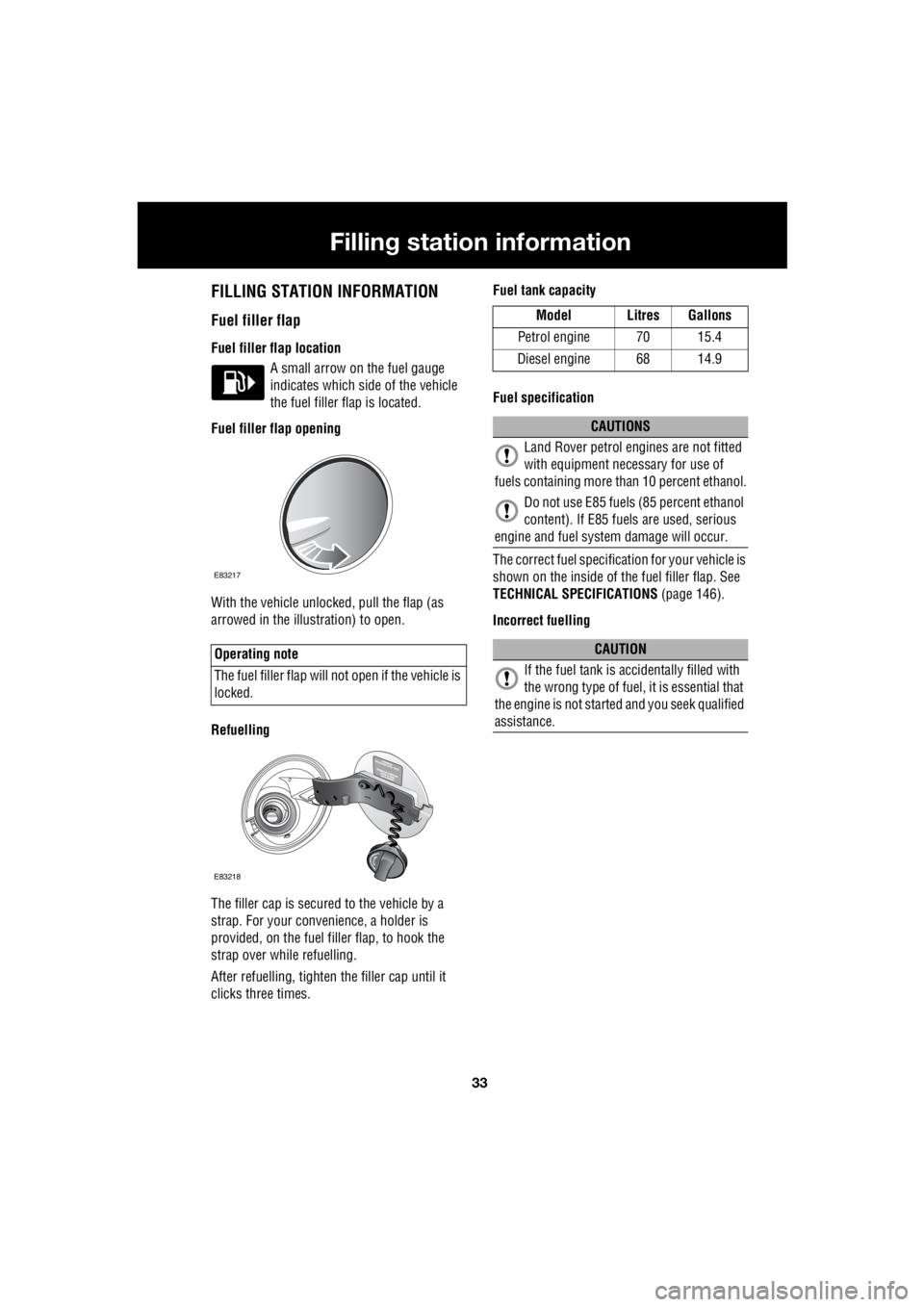
33
Filling station information
R
Filling station informationFILLING STATION INFORMATION
Fuel filler flap
Fuel filler flap location A small arrow on the fuel gauge
indicates which side of the vehicle
the fuel filler flap is located.
Fuel filler flap opening
With the vehicle unlocked, pull the flap (as
arrowed in the illustration) to open.
Refuelling
The filler cap is secured to the vehicle by a
strap. For your conv enience, a holder is
provided, on the fuel filler flap, to hook the
strap over while refuelling.
After refuelling, tighten the filler cap until it
clicks three times. Fuel tank capacity
Fuel specification
The correct fuel specification for your vehicle is
shown on the inside of the fuel filler flap. See
TECHNICAL SPECIFICATIONS (page 146).
Incorrect fuelling
Operating note
The fuel filler flap will not open if the vehicle is
locked.
E83705
E83217
E83218
Model Litres Gallons
Petrol engine 70 15.4
Diesel engine 68 14.9
CAUTIONS
Land Rover petrol engines are not fitted
with equipment necessary for use of
fuels containing more than 10 percent ethanol.
Do not use E85 fuels (85 percent ethanol
content). If E85 fuels are used, serious
engine and fuel system damage will occur.
CAUTION
If the fuel tank is accidentally filled with
the wrong type of fuel, it is essential that
the engine is not starte d and you seek qualified
assistance.
Page 2761 of 3229
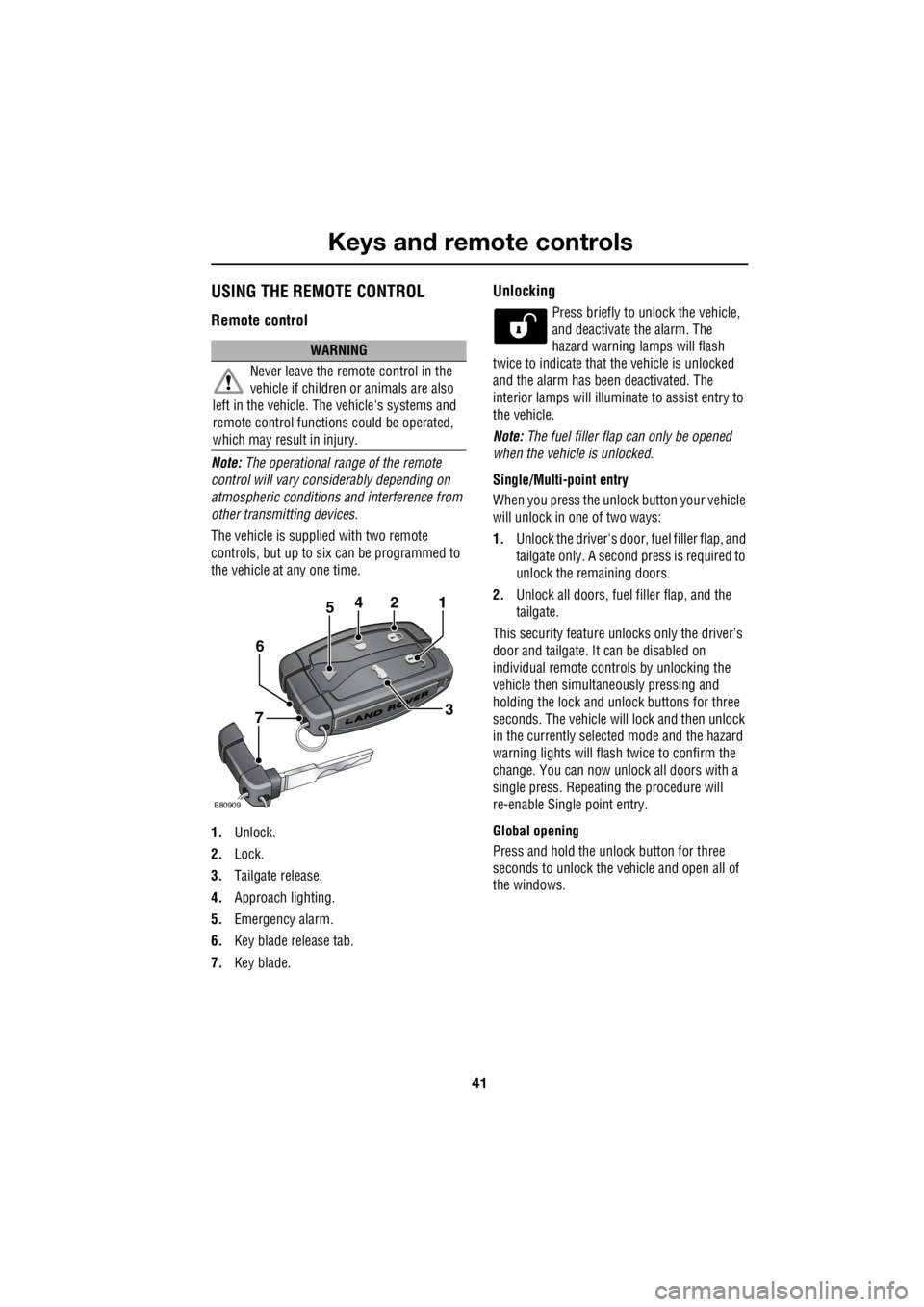
41
Keys and remote controls
R
USING THE REMOTE CONTROL
Remote control
Note: The operational range of the remote
control will vary considerably depending on
atmospheric conditions and interference from
other transmitting devices.
The vehicle is supplied with two remote
controls, but up to six can be programmed to
the vehicle at any one time.
1. Unlock.
2. Lock.
3. Tailgate release.
4. Approach lighting.
5. Emergency alarm.
6. Key blade release tab.
7. Key blade.
Unlocking
Press briefly to unlock the vehicle,
and deactivate the alarm. The
hazard warning lamps will flash
twice to indicate that the vehicle is unlocked
and the alarm has been deactivated. The
interior lamps will illuminate to assist entry to
the vehicle.
Note: The fuel filler flap can only be opened
when the vehicle is unlocked.
Single/Multi- point entry
When you press the unlock button your vehicle
will unlock in one of two ways:
1. Unlock the driver's door, fuel filler flap, and
tailgate only. A second press is required to
unlock the remaining doors.
2. Unlock all doors, fuel filler flap, and the
tailgate.
This security feature unlocks only the driver’s
door and tailgate. It can be disabled on
individual remote controls by unlocking the
vehicle then simultaneously pressing and
holding the lock and unlock buttons for three
seconds. The vehicle will lock and then unlock
in the currently selected mode and the hazard
warning lights will flas h twice to confirm the
change. You can now unlock all doors with a
single press. Repeating the procedure will
re-enable Single point entry.
Global opening
Press and hold the unlock button for three
seconds to unlock the ve hicle and open all of
the windows.
WARNING
Never leave the remote control in the
vehicle if children or animals are also
left in the vehicle. The vehicle's systems and
remote control functions could be operated,
which may result in injury.
2
E80909
451
3
6
7
Page 2762 of 3229
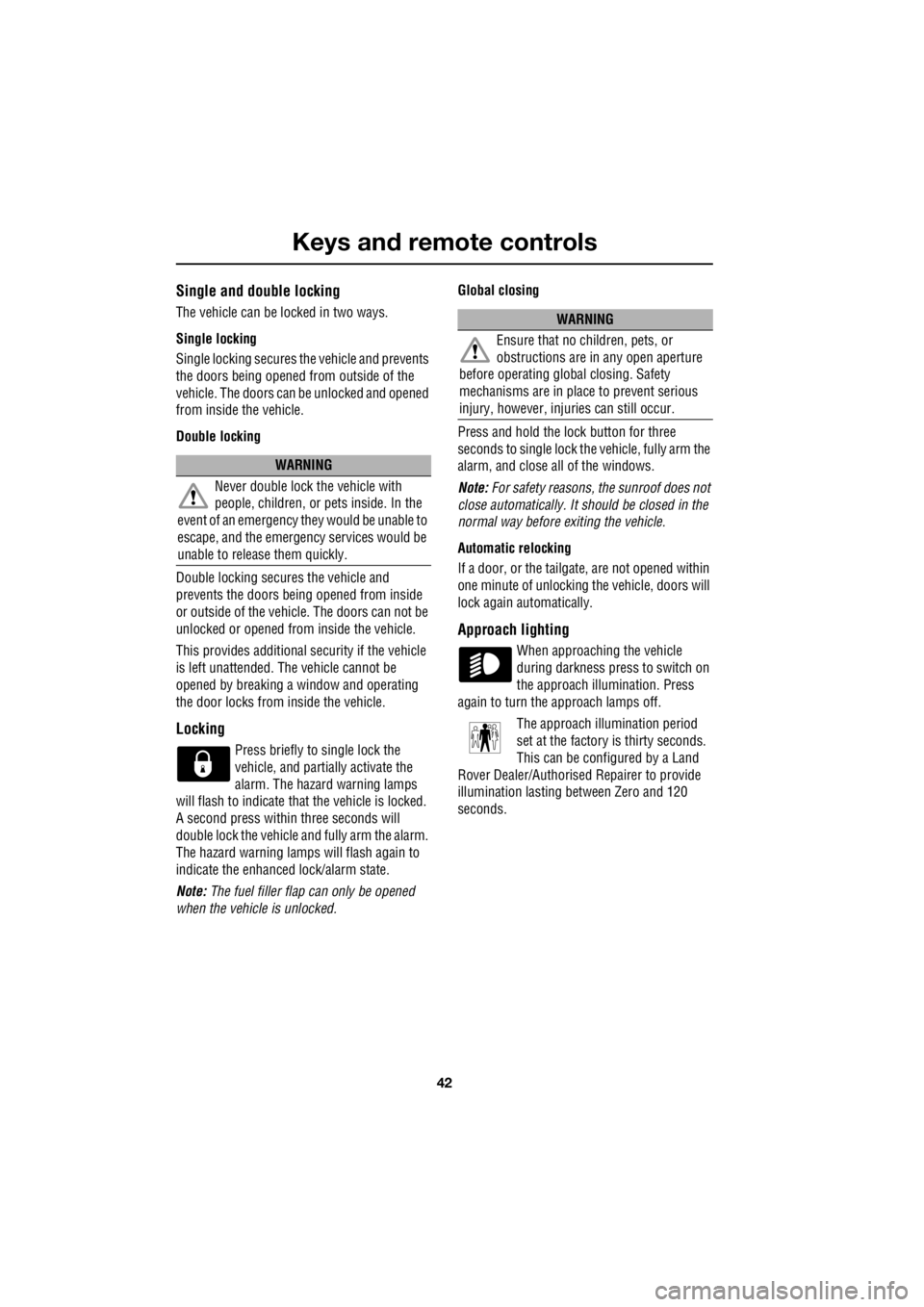
Keys and remote controls
42
L
Single and double locking
The vehicle can be locked in two ways.
Single locking
Single locking secures the vehicle and prevents
the doors being opened from outside of the
vehicle. The doors can be unlocked and opened
from inside the vehicle.
Double locking
Double locking secures the vehicle and
prevents the doors being opened from inside
or outside of the vehicle. The doors can not be
unlocked or opened from inside the vehicle.
This provides additional security if the vehicle
is left unattended. The vehicle cannot be
opened by breaking a window and operating
the door locks from inside the vehicle.
Locking
Press briefly to single lock the
vehicle, and partially activate the
alarm. The hazard warning lamps
will flash to indicate that the vehicle is locked.
A second press within three seconds will
double lock the vehicle and fully arm the alarm.
The hazard warning lamps will flash again to
indicate the enhanced lock/alarm state.
Note: The fuel filler flap can only be opened
when the vehicle is unlocked. Global closing
Press and hold the lock button for three
seconds to single lock the vehicle, fully arm the
alarm, and close all of the windows.
Note: For safety reasons, th e sunroof does not
close automatically. It sh ould be closed in the
normal way before exiting the vehicle.
Automatic relocking
If a door, or the tailgate, are not opened within
one minute of unlocking the vehicle, doors will
lock again automatically.
Approach lighting
When approaching the vehicle
during darkness press to switch on
the approach illumination. Press
again to turn the approach lamps off.
The approach ill umination period
set at the factory is thirty seconds.
This can be configured by a Land
Rover Dealer/Authorised Repairer to provide
illumination lasting between Zero and 120
seconds.
WARNING
Never double lock the vehicle with
people, children, or pets inside. In the
event of an emergency th ey would be unable to
escape, and the emergency services would be
unable to release them quickly.
WARNING
Ensure that no children, pets, or
obstructions are in any open aperture
before operating globa l closing. Safety
mechanisms are in place to prevent serious
injury, however, inju ries can still occur.
Page 2771 of 3229
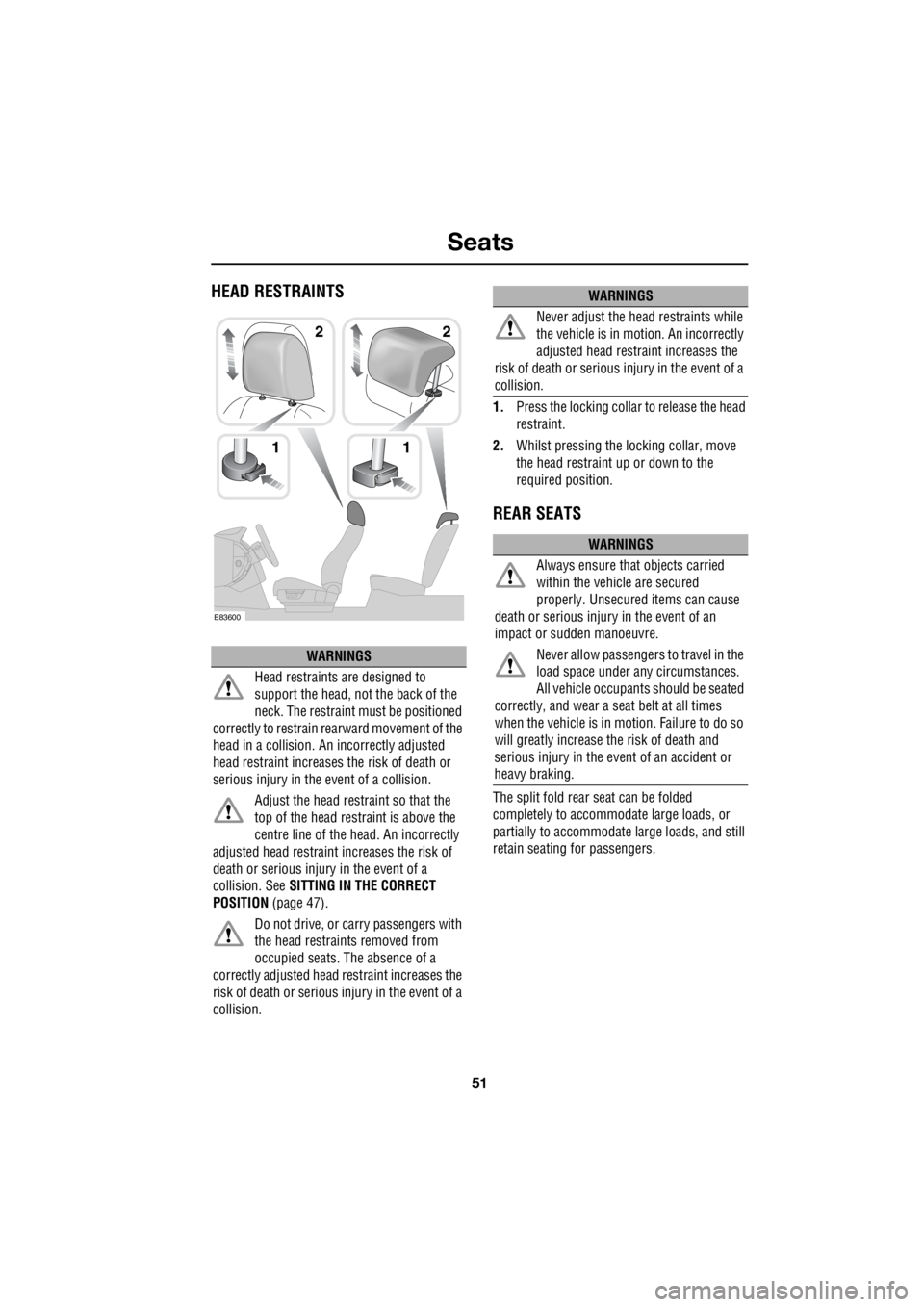
51
Seats
R
HEAD RESTRAINTS
1. Press the locking collar to release the head
restraint.
2. Whilst pressing the locking collar, move
the head restraint up or down to the
required position.
REAR SEATS
The split fold rear seat can be folded
completely to accommodate large loads, or
partially to accommodate large loads, and still
retain seating for passengers.
WARNINGS
Head restraints are designed to
support the head, not the back of the
neck. The restraint must be positioned
correctly to restrain re arward movement of the
head in a collision. An incorrectly adjusted
head restraint increases the risk of death or
serious injury in the event of a collision.
Adjust the head restraint so that the
top of the head restraint is above the
centre line of the he ad. An incorrectly
adjusted head restraint increases the risk of
death or serious injury in the event of a
collision. See SITTING IN THE CORRECT
POSITION (page 47).
Do not drive, or ca rry passengers with
the head restraints removed from
occupied seats. The absence of a
correctly adjusted head restraint increases the
risk of death or serious injury in the event of a
collision.
1
E83600
1
2 2Never adjust the head restraints while
the vehicle is in motion. An incorrectly
adjusted head restraint increases the
risk of death or serious injury in the event of a
collision.
WARNINGS
Always ensure that objects carried
within the vehicle are secured
properly. Unsecured items can cause
death or serious injury in the event of an
impact or sudden manoeuvre.
Never allow passengers to travel in the
load space under any circumstances.
All vehicle occupant s should be seated
correctly, and wear a seat belt at all times
when the vehicle is in motion. Failure to do so
will greatly increase the risk of death and
serious injury in the event of an accident or
heavy braking.
WARNINGS
Page 2772 of 3229
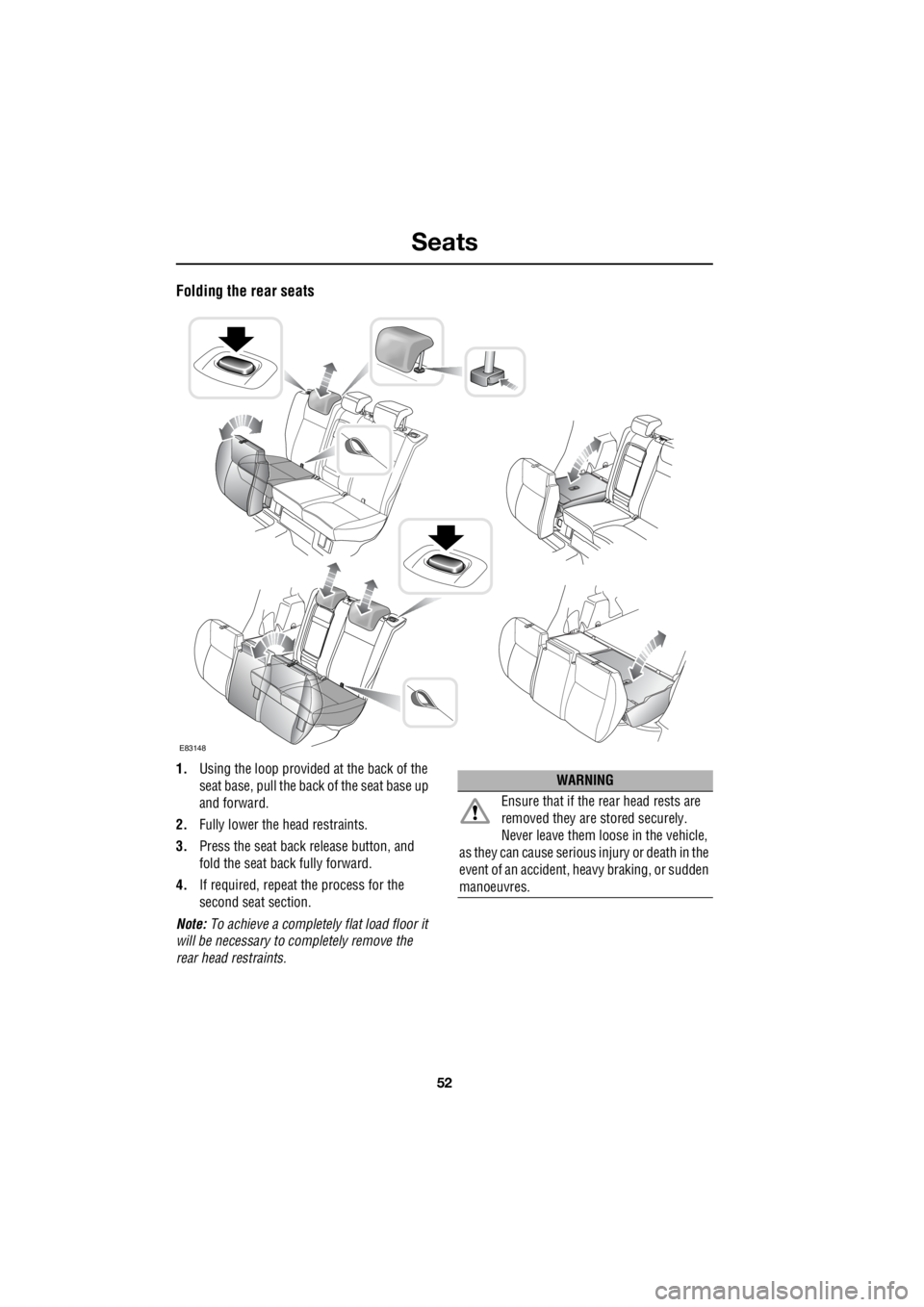
Seats
52
L
Folding the rear seats
1. Using the loop provided at the back of the
seat base, pull the back of the seat base up
and forward.
2. Fully lower the head restraints.
3. Press the seat back release button, and
fold the seat back fully forward.
4. If required, repeat the process for the
second seat section.
Note: To achieve a completely flat load floor it
will be necessary to co mpletely remove the
rear head restraints.
E83148
WARNING
Ensure that if the rear head rests are
removed they are stored securely.
Never leave them loose in the vehicle,
as they can cause serious injury or death in the
event of an accident, he avy braking, or sudden
manoeuvres.
Page 2775 of 3229

55
Seat belts
R
Seat belt checks
Note: If the vehicle is parked on an incline, the
seat belt mechanism may lock. This is not a
fault, and the belt shoul d be gently eased out
from the upper anchorage.
The seat belts should be inspected regularly to
check for fraying, cuts, or wear to the webbing,
and the condition and security of the
mechanism, buckles, adjusters, and mounting
points.
Checks
• With the seat belt fastened, give the
webbing near the buckle a quick upward
pull. The buckle must remain securely
locked.
• With the seat belt unfastened, unreel the
seat belt to the limit of its travel. Check that
it unreels smoothly with no snatches or
snags. Allow the belt to fully retract, again
checking for smooth operation.
• Partially unreel the seat belt, then hold the
tongue plate and give a quick forward pull.
The mechanism must lock and prevent any
further unreeling.
If any of the seat belts fail to meet those
criteria, immediately contact you Land Rover
Dealer/Authorised Repairer.
SEAT BELT REMINDER
If the driver's se at belt is not
fastened when the vehicle is in
motion, a chime will be heard and
the seat belt warning i ndicator will illuminate.
The warning chime and indicator will also be
activated if the front passenger seat is
occupied without the seat belt being fastened.
Note: Objects placed on the front passenger
seat may activate the seat belt reminder
warning chime and indicator. It is
recommended that any objects placed on the
front passenger seat are secured using the seat
belt.
Care must be
taken to avoid
contaminating the seat belt webbing,
and seat belt mechanisms with any
chemicals, liquids, gr it, dirt, or cleaning
products. If the seat belts do become
contaminated they should be replaced
immediately. Contaminated seat belts my not
operate correctly in an impact and cannot be
relied upon.
WARNINGS
Page 2784 of 3229
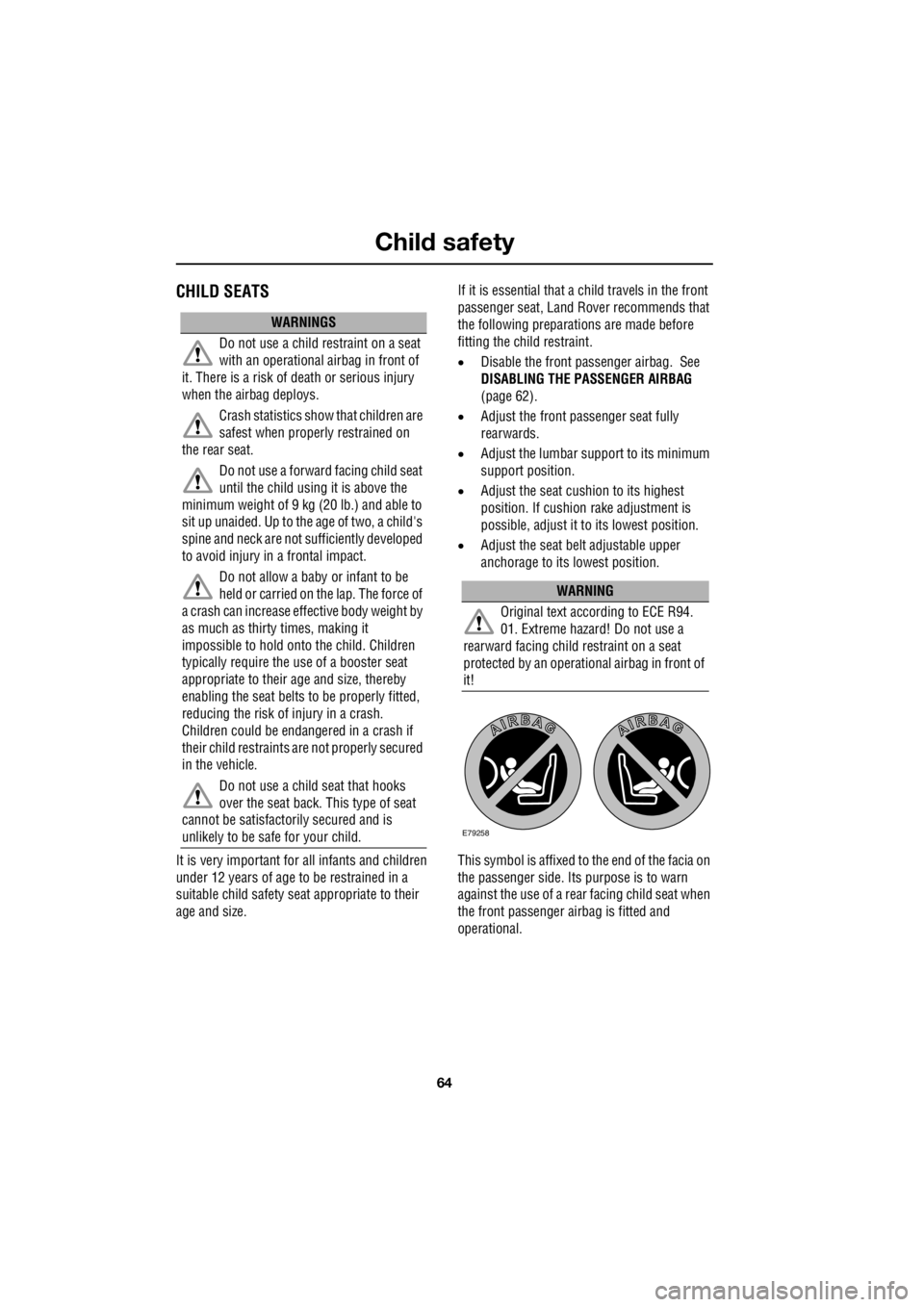
Child safety
64
L
Child safetyCHILD SEATS
It is very important for all infants and children
under 12 years of age to be restrained in a
suitable child safety seat appropriate to their
age and size. If it is essential that a child travels in the front
passenger seat, Land Ro ver recommends that
the following preparations are made before
fitting the child restraint.
• Disable the front pass enger airbag. See
DISABLING THE PASSENGER AIRBAG
(page 62).
• Adjust the front passenger seat fully
rearwards.
• Adjust the lumbar support to its minimum
support position.
• Adjust the seat cushion to its highest
position. If cushion rake adjustment is
possible, adjust it to its lowest position.
• Adjust the seat be lt adjustable upper
anchorage to its lowest position.
This symbol is affixed to the end of the facia on
the passenger side. Its purpose is to warn
against the use of a rear facing child seat when
the front passenger ai rbag is fitted and
operational.
WARNINGS
Do not use a child restraint on a seat
with an operational airbag in front of
it. There is a risk of death or serious injury
when the airbag deploys.
Crash statistics show that children are
safest when properly restrained on
the rear seat.
Do not use a forward facing child seat
until the child using it is above the
minimum weight of 9 kg (20 lb.) and able to
sit up unaided. Up to the age of two, a child's
spine and neck are not sufficiently developed
to avoid injury in a frontal impact.
Do not allow a baby or infant to be
held or carried on the lap. The force of
a crash can increase effective body weight by
as much as thirty times, making it
impossible to hold onto the child. Children
typically require the use of a booster seat
appropriate to their age and size, thereby
enabling the seat belts to be properly fitted,
reducing the risk of injury in a crash.
Children could be enda ngered in a crash if
their child restraints are not properly secured
in the vehicle.
Do not use a child seat that hooks
over the seat back. This type of seat
cannot be satisfactorily secured and is
unlikely to be safe for your child.
WARNING
Original text according to ECE R94.
01. Extreme hazard! Do not use a
rearward facing child restraint on a seat
protected by an operational airbag in front of
it!
E79258